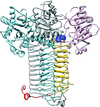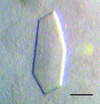issue contents
May 2009 issue

Cover illustration: Geobacillus stearothermophilus 6-phosphogluconate dehydrogenase complexed with 6-phosphogluconate (Cameron et al., p. 450).
structural communications
The structure of pig heart citrate synthase was solved at 1.78 Å resolution. Cys184 was inadvertently modified through disulfide exchange with a component of the crystallization mixture.
PDB reference: pig heart citrate synthase, 3enj, r3enjsf
Open  access
access
 access
accessThe structure of M. tuberculosis N-acetylglucosamine-1-phosphate uridyltransferase (GlmU) was determined by the molecular-replacement method to 3.4 Å resolution in space group I432 and was refined to a final Rwork and Rfree of 0.285 and 0.321, respectively.
PDB reference: GlmU, 3foq, r3foqsf
Crystal structures of the ubiquitin-conjugating enzyme E2-25K M172A mutant protein at pH 6.5 and pH 8.5 were determined to 1.9 and 2.2 Å resolution, respectively. Examination of the structures revealed domain–domain interactions between the UBC and UBA domains which have not previously been reported.
The Nac1 POZ domain resembles the POZ-domain dimers of the POZ-zinc finger transcription factors; the structure will have relevance for the design of therapeutics that target Nac1 function in ovarian cancer.
PDB reference: Nac1 POZ domain, 3ga1, r3ga1sf
Open  access
access
 access
accessThe structure of 6-phosphogluconate dehydrogenase from a moderate thermophile, G. stearothermophilus, is presented and compared with those of orthologous enzymes.
Structure of TTHA1623, a novel metallo-β-lactamase superfamily protein from Thermus thermophilus HB8
The crystal structures of TTHA1623 from T. thermophilus HB8 in an iron-bound and a zinc-bound form have been determined to 2.8 and 2.2 Å resolution, respectively.
crystallization communications
The ketoacyl-acyl carrier protein synthase III (KASIII) encoded by the fabH gene of X. oryzae pv. oryzae is responsible for elongation by two C atoms in fatty-acid synthesis. The fabH gene was cloned, the KASIII enzyme was expressed and preliminary crystallographic study was performed with the aim of understanding the reaction mechanism.
Expression, refolding, crystallization and preliminary X-ray analysis of Pseudomonas aeruginosa AlgE
The expression, purification, refolding and crystallization of the outer membrane protein AlgE from P. aeruginosa is described. The crystals diffracted to 3.0 Å resolution.
The recombinant form of the allergen Can f 2 from C. familiaris was produced, isolated and crystallized in two different forms. Preliminary X-ray diffraction analyses are reported for the two crystal forms of Can f 2.
The TON_0887 gene product was purified and crystallized at 295 K. A 2.2 Å resolution data set was collected using synchrotron radiation.
Glutathione S-transferases (GSTs) are a group of detoxifying enzymes that are found in animals, plants and microorganisms. Here, the crystallizations of two cyanobacterial GSTs are reported with the aim of determining their atomic structures.
The crystallization of the receiver domain of the histidine kinase CYTOKININ-INDEPENDENT1 from A. thaliana is described. The crystals diffracted to 2.0 Å resolution.
The crystallization and results of multiwavelength anomalous diffraction studies of a recombinant C3-inhibitory fragment of Efb from S. aureus are reported.
The bifunctional enzyme catalase-phenol oxidase from S. thermophilum was crystallized by the hanging-drop vapour-diffusion method in space group P21 and diffraction data were collected to 2.8 Å resolution.
Get3 is a cytosolic ATPase which can recognize and bind the transmembrane domain of tail-anchored proteins. Yeast Get3 has been crystallized and the crystals diffracted to 2.7 Å resolution using a synchrotron X-ray source.
Laminin-binding protein from S. agalactiae was expressed, purified and crystallized and X-ray diffraction data were collected to 2.5 Å resolution.
A joint X-ray and neutron crystallographic study has been initiated to determine the specific water network and the protonation states of the hydrophilic residues that coordinate it in human carbonic anhydrase II.
XynC, a glycosyl hydrolase family 5 xylanase from B. subtilis, has been purified and crystallized with the primary goal of structural determination and characterization of a second xylanase from this large catalytically diverse glycosyl hydrolase family.
Mouse endonuclease G without its mitochondrial localization signal (amino-acid residues 1–43) was successfully overexpressed, purified and crystallized using a microbatch method under oil.
A. aeolicus GidA has been crystallized in two different crystal forms: forms I and II. X-ray diffraction data were collected to 3.2 and 2.3 Å resolution, respectively, using a synchrotron-radiation source.
A protease-resistant mutant form of human galectin-8 has been crystallized and diffraction data have been collected to 3.4 Å resolution.
The crystallization of an alginate-binding protein isolated from Sphingomonas sp. A1 and the results of preliminary crystallographic analysis of this protein are presented.
The preliminary X-ray data of β-microseminoprotein isolated from human seminal plasma at 2.4 Å resolution are reported.
The first crystallographic study of a plant subtilase, SBT3 from S. lycopersicum, is reported.
The gene that encodes human coronavirus HKU1 nonstructural protein 9 was cloned and expressed in Escherichia coli and the protein was subjected to crystallization trials.
Human ADP-ribosylhydrolase 1, which cleaves the glycosidic bond between ADP-ribose and specific Arg residues in proteins, has been cloned, expressed, purified and crystallized.
A recombinant serine protease inhibitor, CrSPI-1, from horseshoe crab, which inhibits subtilisin with a Ki of 10−9 M, has been cloned, expressed, purified and cocrystallized with subtilisin. The crystals diffracted to 2.6 Å resolution.
Isocitrate dehydrogenase kinase/phosphatase has been crystallized in three different crystal forms. Data were collected from each crystal form for structure determination.


 journal menu
journal menu








































![[publBio]](/logos/publbio.gif)





